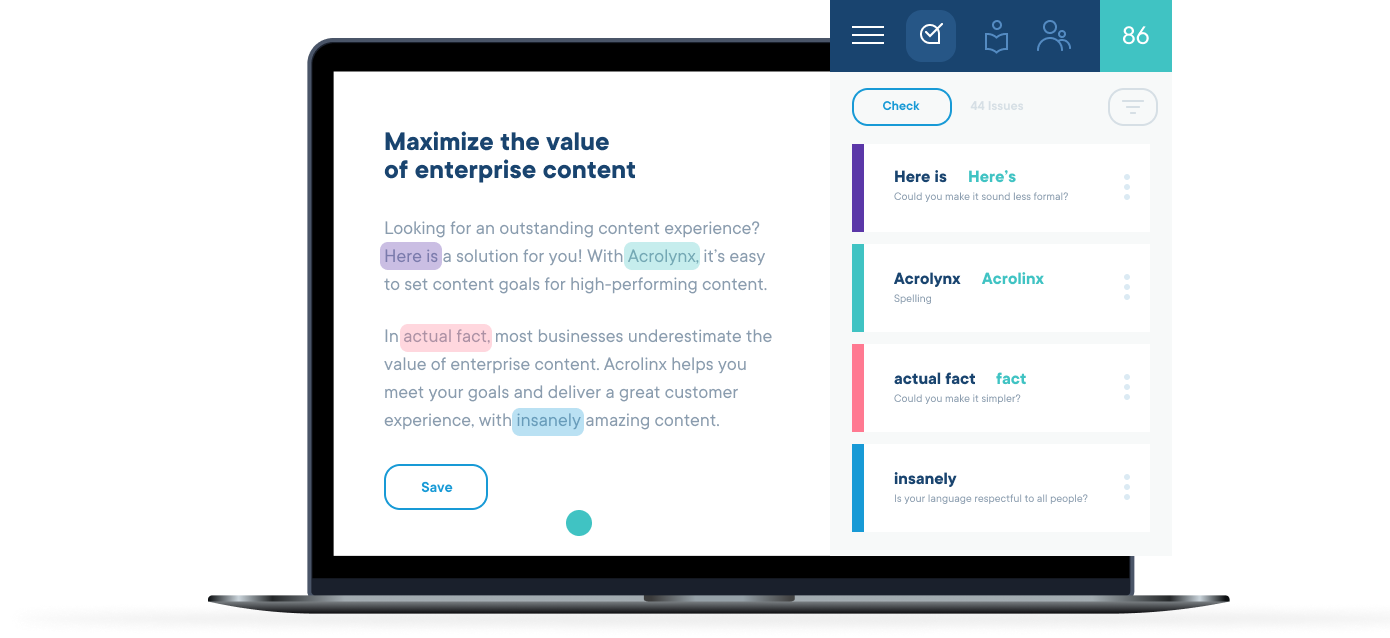Find the Best AI Writing Assistant for You
Are you looking for an Artificial Intelligence (AI) writing assistant to help you create content? Then you’ve come to the right place. Find the right tool for your needs and explore how to use AI best to create high-quality content that converts.
Looking for the best writing assistant software for you and your team? Take the quiz:
To improve content and make content processes more efficient, an AI writing assistant is just the beginning. For impactful enterprise content, use AI-powered editorial assistance that’s part of an editorial management system.
What is editorial management?
Editorial management is the process of planning, creating, and overseeing written content to make sure it aligns with a company’s goals, standards, and brand identity.
Why you need more than an AI writing assistant
More content, more need for assistance
Content is spreading beyond the company walls. For example:
- Web content
- Social media posts
- GitHub repositories
Information within your own websites: from knowledge bases, to tech documentation centers, marketing hubs and more
To power the customer journey, more people are producing more content (and more content types) than ever before. AI tools help you create content to meet rising demand.
But without editorial management and content governance, a writing assistant becomes more of a hindrance than a help.
Basic writing support
A writing assistant is one of the more basic ways of adding AI into your content workflow. Usually, it only helps with simple grammar and spelling. It doesn’t provide valuable alignment of brand voice and company terminology across all enterprise content teams.
What does that mean?
Enterprises create lots of content for different audiences. To make sure all content represents the brand the best way possible, you need more than correct content, but content that has a consistent tone of voice and terminology.
Enterprises use style guides and terminology solutions to capture their corporate language. But how do you make writers and editors use it? This is something AI writing assistance software can’t help with. Only an enterprise editorial management system provides enterprise guidance.
Basic writing support is helpful for casual writers and individuals. But enterprise content needs extra layers of alignment and configurability.
Enterprise content needs content governance
Content governance operationalizes and maintains content strategy and impact over time. It also means supporting your content teams directly in the applications they use.
Content governance is one of the main differentiators between an AI writing software and an editorial management system. Only the latter can provide full content governance.
AI writing assistants vs. editorial management systems
Let’s explore the differences between an editorial management system and a writing assistant.
| AI writing assistant | Editorial Management System |
|
|
An editorial management system can do everything an AI writing tool can do — and more. It helps writers create impactful content that meets your goals. All while keeping pesky spelling and grammar errors at bay. An editorial management system makes the best of your content.
It provides an extra layer of support, guidance, and protection by offering the following benefits:
- Improved editorial efficiency: Speed up content production by assisting writers and editors as they create and edit content.
- Reduced risk and increased compliance: Use content automation to regularly check drafted and published content. Make sure content meets regulatory, compliance, and inclusive language goals.
- Consistent brand experience: Keep content aligned with your enterprise brand voice and style guidelines.
Bringing performance and quality together
What’s more, an editorial management system compares content performance data with content quality data. What do we mean by that?
Let’s dive into an example: Imagine that you’ve spent a lot of time creating a blog post. Maybe you even used an AI writing assistant to help generate the content.
Yet, when you look at the performance data, the bounce rate is high and the average engagement time is low. Your spelling and grammar are perfect, but the content isn’t connecting with your audience. Your audience doesn’t interact with your content. And your AI writing assistant isn’t helping: It’s not telling you “why” or offering any guidance on how you can improve.
An editorial management system provides insight into both content quality and performance metrics.
So, getting back to that blog post that isn’t performing how you want, now you can understand why. Maybe your sentence structure is too complicated and lacks clarity. Or your writing style isn’t in your brand tone of voice. Maybe you used conflicting product descriptions and names in your blog post or offensive language that upset your audience.
It’s frustrating to figure out why something isn’t performing as expected.
An editorial management system is able to identify why content isn’t performing. To do so, it combines content quality metrics with your performance data. And of course, it provides you with the tools you need to improve your content efficiently.
An AI writing assistant helps you improve content, too. But it doesn’t offer comprehensive content analytics, and also doesn’t help deciding which content piece to fix first. You have to figure out these aspects by way of time-intensive research.
Time you can save with an editorial management system.
Generative AI + editorial management = the perfect match
Generative AI can streamline your content creation process and increase content velocity. But everyone knows that generative AI also presents major legal, financial, and compliance risks for your brand. From off-brand messaging and incorrect information to offensive content that could have major consequences.
Tools like Acrolinx increase efficiency with generative AI, but in the secure environment of an editorial management system.


Discover what an AI-powered enterprise editorial management system can do for you
Schedule a demo and learn more.
Let’s talk